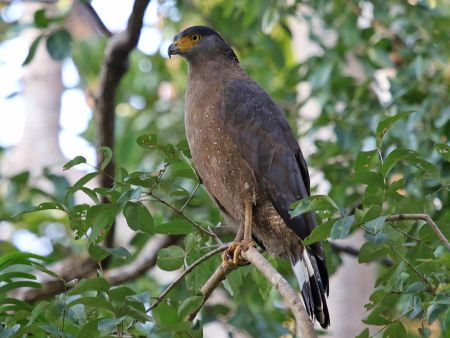Sbarnhardt (talk | contribs) (FA changed to Iberian Chiffchaff for February 2024) |
Sbarnhardt (talk | contribs) (FA changed to Crested Serpent Eagle for May 2024) |
||
| (3 intermediate revisions by 2 users not shown) | |||
| Line 1: | Line 1: | ||
| − | <div style="{{psubheader}}">Featured Article: '''[[ | + | <div style="{{psubheader}}">Featured Article: '''[[Crested Serpent Eagle]]'''</div> |
| − | [[Image: | + | [[Image:SnakeHEagleH 2976.jpg|thumb|450px|left|Subspecies ''cheela''<br />Photo © by {{user|mikemiki|mikemik}} <br />Kanha National Park, Mandla, [[India]], 20 November 2015]] |
| − | == Identification== | + | ==Identification== |
| − | + | Medium large raptor about 50–74 cm (19¾-29 in) in length. <br /><br /> | |
| − | Pale | + | '''Adult'''<br /> |
| + | Dark brown upperparts and head<br /> | ||
| + | Hooded appearance at rest<br /> | ||
| + | Pale brown underparts and underwing coverts<br /> | ||
| + | Appears large-headed and owl-like due to face s hape and position of eyes<br /> | ||
| + | Tail and flight feathers black with broad white stripes<br /><br /> | ||
| − | + | ==Distribution== | |
| − | + | Southern [[Asia]]<br /> | |
| − | + | *Widespread and generally common from northern [[India]], south to [[Sri Lanka]], east to southern [[China]], Hainan, [[Taiwan]] and the southern Ryukyu Islands. South to the [[Andaman Islands]] and [[Malay Peninsula]]. <br /> | |
| − | + | *Also breeds on Palawan, [[Borneo]], [[Sumatra]], [[Java]] and many smaller islands. | |
| − | [[ | ||
| − | |||
| − | |||
| − | |||
| − | [[ | ||
| − | |||
| − | |||
| − | |||
| − | |||
| − | |||
| − | == | + | ==Taxonomy== |
| − | + | Taxonomy confused and confusing in the face of little research and multiple distinct forms. | |
| − | |||
| − | + | Subspecies ''abbotti'' may be elevated as "Simeulue Serpent-eagle", ''S. abbotti'', ''sipora'' as "Mentawai Serpent-eagle", ''S. sipora'', ''asturinus'' as "Nias Serpent-eagle", ''S. asturinus'', ''baweanus'' as "Bawean Serpent-eagle", ''S. baweanus'' and (sometimes) ''natunensis'' as "Natuna Serpent-eagle", ''S. natunensis'' | |
| − | |||
| + | Clements recognizes 21 subspecies | ||
| + | ==Habitat== | ||
| + | Forest and forest edge, riverine woodland, farmland and sometimes near villages. Occurs up to 3,000m in the [[Himalayas]]. | ||
| + | ==Breeding== | ||
| + | A large stick nest is constructed in the middle of a tall tree. The clutch consists of 1, occasionally two, eggs. These are incubated by the female for about 35 days, with the male helping to feed them once they are hatched. They leave the nest when they are about 2 months old. | ||
| + | '''[[Crested Serpent Eagle|Read Full Article.......]]''' | ||
| − | |||
Revision as of 11:58, 1 May 2024
Identification
Medium large raptor about 50–74 cm (19¾-29 in) in length.
Adult
Dark brown upperparts and head
Hooded appearance at rest
Pale brown underparts and underwing coverts
Appears large-headed and owl-like due to face s hape and position of eyes
Tail and flight feathers black with broad white stripes
Distribution
Southern Asia
- Widespread and generally common from northern India, south to Sri Lanka, east to southern China, Hainan, Taiwan and the southern Ryukyu Islands. South to the Andaman Islands and Malay Peninsula.
- Also breeds on Palawan, Borneo, Sumatra, Java and many smaller islands.
Taxonomy
Taxonomy confused and confusing in the face of little research and multiple distinct forms.
Subspecies abbotti may be elevated as "Simeulue Serpent-eagle", S. abbotti, sipora as "Mentawai Serpent-eagle", S. sipora, asturinus as "Nias Serpent-eagle", S. asturinus, baweanus as "Bawean Serpent-eagle", S. baweanus and (sometimes) natunensis as "Natuna Serpent-eagle", S. natunensis
Clements recognizes 21 subspecies
Habitat
Forest and forest edge, riverine woodland, farmland and sometimes near villages. Occurs up to 3,000m in the Himalayas.
Breeding
A large stick nest is constructed in the middle of a tall tree. The clutch consists of 1, occasionally two, eggs. These are incubated by the female for about 35 days, with the male helping to feed them once they are hatched. They leave the nest when they are about 2 months old.




